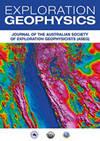The resistive limit response of an ellipsoidal conductor: a magnetostatic formulation
IF 0.8
4区 地球科学
Q4 GEOCHEMISTRY & GEOPHYSICS
引用次数: 0
Abstract
AbstractInterpreting transient electromagnetic (TEM) anomalies in terms of conductive rectangular plates is effective in many situations. However, not all conductors are thin and planar. Triaxial ellipsoid conductors are an attractive alternative: geometrically simple (corner-free), mathematically tractable at early and late time limits, and able to encompass shapes ranging from discs to elongate lenses to equi-dimensional pods. Accordingly a fast magnetostatic algorithm has been developed to compute the resistive limit (RL) response of a ellipsoidal conductor, which may also be permeable. The algorithm has been validated against new analytic resistive limit solutions for spherical and spheroidal conductors and against 3D multigrid finite difference modelling for a triaxial ellipsoidal conductor. A uniformly conductive ellipsoid supports three fundamental current modes in the resistive limit, an independent mode for excitation parallel to each of the principal axes. The RL current density increases linearly with radial distance from the ellipsoid centre. A formula for the time constant of an oblate spheroid has been derived for excitation parallel to its rotational axis, namely τ3≈σμ0bc/(4+6c/b), where σ is the conductivity and c and b are respectively the minor and major radii.KEYWORDS: Ellipsoidresistive limitelectromagneticsmodelling AcknowledgementsI am indebted to the late Dr. Yves Lamontagne (Lamontagne Geophysics) who kindly modelled triaxial ellipsoid RL responses using his MGEM 3D multigrid finite difference program and who provided physical insights. Dr. David Clark (CSIRO/Integrated Magnetics LLC) assisted with theoretical aspects, and in particular confirmed my derivation of equation (22) for the RL field inside a spherical conductor.Disclosure statementNo potential conflict of interest was reported by the author(s).椭球导体的电阻极限响应:静磁公式
摘要用导电矩形板解释瞬变电磁(TEM)异常在许多情况下是有效的。然而,并不是所有的导体都是薄而平面的。三轴椭球导体是一种有吸引力的替代方案:几何上简单(无角),在早期和晚期的时间限制下在数学上易于处理,并且能够涵盖从圆盘到拉长透镜到等维吊舱的各种形状。因此,我们开发了一种快速的静磁算法来计算椭球导体的电阻极限(RL)响应,这种椭球导体也可能是可渗透的。该算法已通过球面和球面导体的新的解析电阻极限解和三轴椭球导体的三维多网格有限差分模型进行了验证。一个均匀导电的椭球体在电阻极限下支持三种基本电流模式,一种与每个主轴平行的独立激励模式。RL电流密度随距椭球中心径向距离的增加而线性增加。推导了平行于其旋转轴的椭球的时间常数公式τ3≈σμ0bc/(4+6c/b),其中σ为电导率,c和b分别为小半径和大半径。感谢已故的Yves Lamontagne博士(Lamontagne地球物理学),他用他的MGEM 3D多网格有限差分程序模拟了三轴椭球体RL响应,并提供了物理见解。David Clark博士(CSIRO/Integrated Magnetics LLC)在理论方面提供了帮助,特别是证实了我对球形导体内RL场的推导公式(22)。披露声明作者未报告潜在的利益冲突。
本文章由计算机程序翻译,如有差异,请以英文原文为准。
求助全文
约1分钟内获得全文
求助全文
来源期刊

Exploration Geophysics
地学-地球化学与地球物理
CiteScore
2.30
自引率
0.00%
发文量
33
审稿时长
>12 weeks
期刊介绍:
Exploration Geophysics is published on behalf of the Australian Society of Exploration Geophysicists (ASEG), Society of Exploration Geophysics of Japan (SEGJ), and Korean Society of Earth and Exploration Geophysicists (KSEG).
The journal presents significant case histories, advances in data interpretation, and theoretical developments resulting from original research in exploration and applied geophysics. Papers that may have implications for field practice in Australia, even if they report work from other continents, will be welcome. ´Exploration and applied geophysics´ will be interpreted broadly by the editors, so that geotechnical and environmental studies are by no means precluded.
Papers are expected to be of a high standard. Exploration Geophysics uses an international pool of reviewers drawn from industry and academic authorities as selected by the editorial panel.
The journal provides a common meeting ground for geophysicists active in either field studies or basic research.
 求助内容:
求助内容: 应助结果提醒方式:
应助结果提醒方式:


